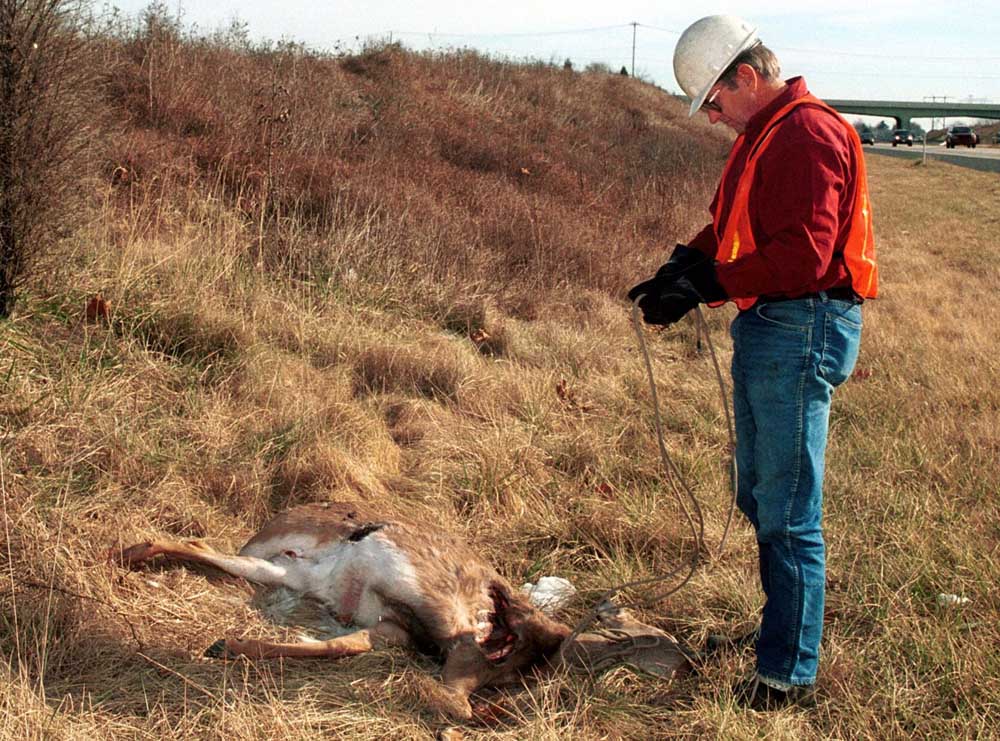Reducing roadkill a possible savior for sage grouse
Published 12:00 pm Friday, January 28, 2022

- Carcasses of roadkilled deer can attract scavengers, including ravens.
The connection between a dead deer rotting on the roadside, a live raven and a live (or budding) sage grouse is a somewhat circuitous one.
And not just because only two of the three things are birds.
Sometimes, though, this trio forges a link of sorts, and the only one that prospers from the confluence is the raven.
The problem, said Dallas Hall Defrees, coordinator for the Baker County Sage Grouse Local Implementation Team , is that the deer carcass can attract ravens, which then tend to stay in the area, searching for other easy meals.
Including sage grouse eggs.
Or recently hatched sage grouse chicks.
Research has shown that ravens can be a significant predator of sage grouse eggs and chicks, Defrees said.
“Ravens are very opportunistic,” she said.
A survey in the spring of 2016 in some of Baker County’s best sage grouse habitat, mainly east of Baker City , showed raven populations were high enough to potentially pose a threat to sage grouse.
Research suggests that ravens pose a particular threat when their population densities exceed 0.7 birds per square kilometer, Lee Foster, then the Oregon Department of Fish and Wildlife’s sage grouse conservation coordinator, said in 2016.
The 2016 ODFW survey between April 1 and May 30 — when sage grouse are nesting — yielded a preliminary population density estimate of 0.9 ravens per square kilometer.
Identifying, and trying to mitigate, threats to sage grouse is the focus of the effort that Defrees, a Baker County native, is coordinating.
That campaign is spearheaded by a six-year, $6.2 million grant from the Oregon Watershed Enhancement Board that started in 2019. The money comes from Oregon Lottery revenue.
Defrees said the roadkill project, which is in its preliminary stages and has no definite timeline, aims to reduce the number of raven-attracting carcasses along state Highway 86, which runs east from Baker City and bisects some of the county’s best sage grouse habitat.
“If we can deter ravens from being there, it would be highly beneficial for sage grouse,” Defrees said.
She emphasized, though, that curbing the presence of carcasses is, at best, a partial solution.
“This is not to say this is going to solve our raven problem, because it’s not,” she said. “But it is a deterrent. If we’re doing a good job of denying food sources to ravens, they’ll have to travel farther, and probably not spend as much time in that area (that includes sage grouse habitat).”
Sage grouse tend to remain in relatively small areas, Defrees said, so the consistent presence of ravens can constitute an ongoing threat to the grouse.
Defrees said Oregon State University researchers are studying the effects on raven concentrations by removing roadkilled animals in northern Malheur County.
Dealing with ravens is not as simple as summoning a group of volunteers with shotguns. That’s because ravens, unlike sage grouse, are protected under the Migratory Bird Treaty Act.
That federal law does allow government agencies to apply for permits to kill ravens, however.
The U.S. Fish and Wildlife Service and ODFW last year started a two-year project to remove raven nests in and near sage grouse habitat in Baker County, Defrees said.
Depending on how effective that tactic is at curbing raven populations, the agencies could also get a permit to kill ravens, Defrees said.
Sage grouse, which are about the size of a chicken, have been a candidate for federal protection for more than a decade.
In September 2015 the U.S. Fish and Wildlife Service decided not to list the bird as threatened or endangered.
But environmental groups have repeatedly asked the federal government to classify the bird as a threatened or endangered species, a decision that could curtail activities, including cattle grazing and motorized vehicle use on public land, that could degrade sage grouse habitat.
Although other animals are killed by cars, deer are the biggest animals frequently hit on Highway 86 east of Baker City.
The challenges, Defrees said, are how to gather the carcasses in a timely way, and then what to do with them.
She said Oregon Department of Transportation crews can’t be expected to pick up carcasses and haul them to a processing site.
The proposed place for that is Baker Sanitary Service’s landfill near Sutton Creek, a few miles southeast of Baker City off Old Highway 30.
The idea, Defrees said, is to turn the carcasses into compost.
Baker Sanitary opened a compost facility at the landfill in the summer of 2021. It initially processed yard waste, but landfill manager Garrett Virtue said the company wants to add food waste and other meat to the facility. Deer carcasses present a different challenge, he said, because they would need to be ground up before being added to the compost process.
“If we can deter ravens from being there, it would be highly beneficial for sage grouse.”
— Dallas Hall Defrees, coordinator, Baker Sage Grouse Local Implementation Team






